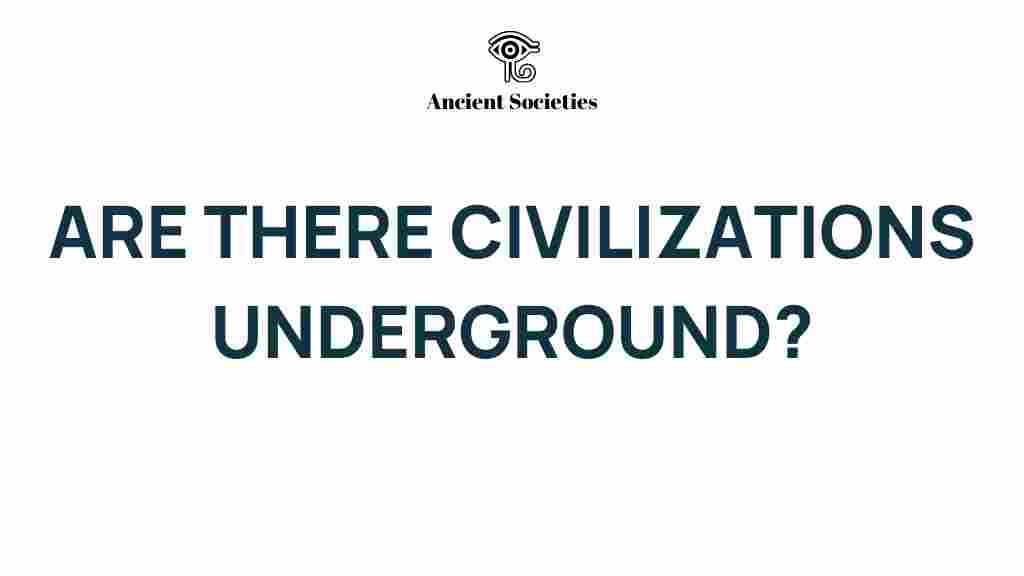Unearthing the Secrets: Are There Civilizations Underground?
The concept of underground civilizations has fascinated humanity for centuries. From ancient myths and folklore to modern archaeological finds, the idea of hidden societies beneath our feet sparks curiosity and intrigue. But what is the truth? Are there indeed civilizations underground waiting to be discovered? In this article, we will delve into the world of archaeology, explore the mysteries of subterranean cities, and examine the evidence for lost civilizations that may have thrived beneath the surface.
The Allure of Hidden Societies
Throughout history, stories of underground societies have captured the imagination. Some cultures believed in vast networks of tunnels inhabited by entire communities, while others spoke of ancient cultures that constructed elaborate underground cities. The allure of these hidden worlds is not just a product of fantasy; there are numerous archaeological finds that suggest the existence of such places.
Historical Context of Underground Civilizations
Many ancient cultures have left behind evidence of subterranean constructions:
- Capadocia, Turkey: This region is famous for its underground cities, such as Derinkuyu, which could house thousands of people and included living quarters, storage rooms, and even places of worship.
- Naours Caves, France: These underground tunnels were used as a refuge during the Hundred Years’ War, showcasing the strategic importance of hidden societies during conflicts.
- The Catacombs of Paris: These extensive underground ossuaries reveal the complex relationship between the living and the dead in urban spaces.
Unearthing Evidence of Subterranean Cities
To understand if there are indeed civilizations underground, we must explore the findings of archaeologists around the globe. Through meticulous excavation and research, they have uncovered remarkable sites that offer a glimpse into ancient cultures.
Archaeological Discoveries
Archaeologists have unearthed various structures that point to the existence of underground civilizations:
- Tutankhamun’s Tomb: While not entirely underground, it is situated beneath the surface and has revealed much about the ancient Egyptian culture.
- The Underground City of Derinkuyu: As mentioned before, this city is a testament to the engineering prowess of ancient societies.
- Subterranean Temples: In South America, various civilizations built temples and ceremonial sites underground, indicating their spiritual significance.
Urban Exploration: A Modern Fascination
Urban exploration has become a popular activity among adventure seekers and historians alike. Many urban explorers venture into abandoned tunnels, old subway systems, and forgotten basements to uncover the stories of past civilizations. This modern pursuit of adventure often leads to the discovery of artifacts and remnants of old cultures, igniting interest in the idea of hidden societies.
The Role of Technology in Discovering Underground Cultures
Advancements in technology have greatly enhanced our ability to explore underground spaces. Tools such as ground-penetrating radar (GPR), 3D scanning, and drone technology allow archaeologists to map out and investigate areas that were previously inaccessible.
Step-by-Step Process of Discovering Underground Civilizations
When archaeologists set out to uncover the mysteries of underground civilizations, they follow a detailed process. Here’s a simplified breakdown of the steps involved:
Step 1: Research and Hypothesis Formation
Before any excavation begins, thorough research is conducted. This may involve:
- Studying historical texts and maps.
- Consulting with local historians and experts.
- Identifying areas with reported sightings or folklore about underground societies.
Step 2: Ground Surveys
Using technologies like GPR, archaeologists conduct ground surveys to identify potential underground structures. This non-invasive method helps in mapping out what lies beneath the surface without disturbing the ground.
Step 3: Excavation
Once potential sites are identified, controlled excavations are carried out. This process involves:
- Carefully removing layers of soil.
- Documenting findings in situ (in their original place).
- Using excavation tools to minimize damage to artifacts.
Step 4: Analysis and Preservation
After excavation, the artifacts and structures found are analyzed. This includes:
- Cleaning and restoring artifacts.
- Dating materials using methods like carbon dating.
- Publishing findings to share with the archaeological community and the public.
Troubleshooting Tips for Urban Explorers
For those interested in exploring urban areas that may contain remnants of civilizations underground, it’s essential to follow safety precautions:
- Research Locations: Always research the site beforehand. Understand its history and any potential hazards.
- Bring the Right Gear: Equip yourself with flashlights, sturdy footwear, and a first aid kit.
- Never Explore Alone: Always go with a partner or a group for safety.
- Respect the Site: Leave no trace and avoid vandalism to preserve the site’s integrity.
Conclusion: The Mysteries Beneath Our Feet
The quest to uncover underground civilizations is an ongoing journey filled with mystery and excitement. While there is ample evidence to suggest that ancient cultures built intricate networks beneath the earth, the full extent of these hidden societies remains largely undiscovered. As technology advances and urban exploration gains popularity, the potential for discovering lost civilizations continues to grow.
If you’re intrigued by the idea of civilizations underground, consider diving deeper into the world of archaeology and urban exploration. For more information on archaeological discoveries, check out Archaeology Magazine. And remember, the next time you walk through your city, think about the hidden histories that may lie just below your feet.
By embracing the mysteries of the past, we can learn more about our shared heritage and perhaps uncover the secrets of civilizations that once thrived underground.
This article is in the category Archaeology and created by AncientSocieties Team
